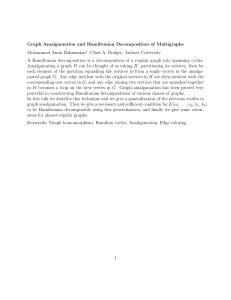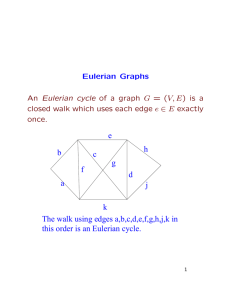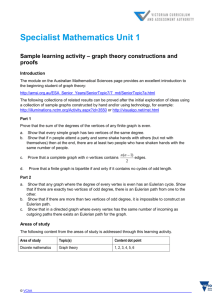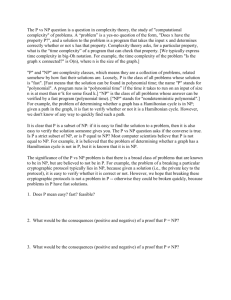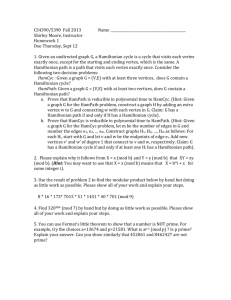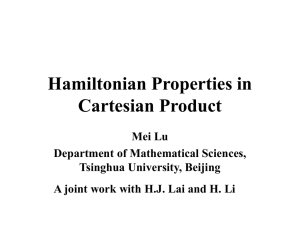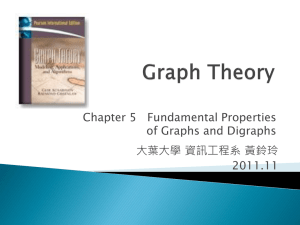Exam 2 + Key - FIU Faculty Websites
advertisement
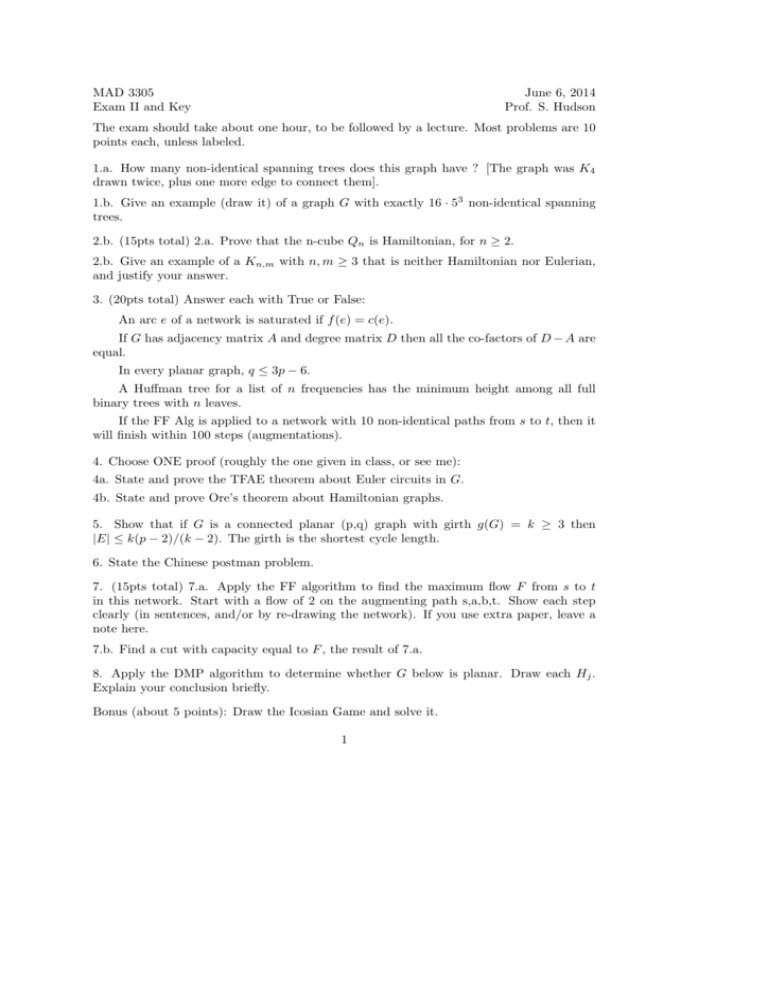
MAD 3305
Exam II and Key
June 6, 2014
Prof. S. Hudson
The exam should take about one hour, to be followed by a lecture. Most problems are 10
points each, unless labeled.
1.a. How many non-identical spanning trees does this graph have ? [The graph was K4
drawn twice, plus one more edge to connect them].
1.b. Give an example (draw it) of a graph G with exactly 16 · 53 non-identical spanning
trees.
2.b. (15pts total) 2.a. Prove that the n-cube Qn is Hamiltonian, for n ≥ 2.
2.b. Give an example of a Kn,m with n, m ≥ 3 that is neither Hamiltonian nor Eulerian,
and justify your answer.
3. (20pts total) Answer each with True or False:
An arc e of a network is saturated if f (e) = c(e).
If G has adjacency matrix A and degree matrix D then all the co-factors of D − A are
equal.
In every planar graph, q ≤ 3p − 6.
A Huffman tree for a list of n frequencies has the minimum height among all full
binary trees with n leaves.
If the FF Alg is applied to a network with 10 non-identical paths from s to t, then it
will finish within 100 steps (augmentations).
4. Choose ONE proof (roughly the one given in class, or see me):
4a. State and prove the TFAE theorem about Euler circuits in G.
4b. State and prove Ore’s theorem about Hamiltonian graphs.
5. Show that if G is a connected planar (p,q) graph with girth g(G) = k ≥ 3 then
|E| ≤ k(p − 2)/(k − 2). The girth is the shortest cycle length.
6. State the Chinese postman problem.
7. (15pts total) 7.a. Apply the FF algorithm to find the maximum flow F from s to t
in this network. Start with a flow of 2 on the augmenting path s,a,b,t. Show each step
clearly (in sentences, and/or by re-drawing the network). If you use extra paper, leave a
note here.
7.b. Find a cut with capacity equal to F , the result of 7.a.
8. Apply the DMP algorithm to determine whether G below is planar. Draw each Hj .
Explain your conclusion briefly.
Bonus (about 5 points): Draw the Icosian Game and solve it.
1
Remarks and Answers: The average was 53 out of 100 based on the top 10 scores. The
high scores were 69 and 67. The worst results were again on homework problems (2 and
5). The final will emphasize homework as much as this exam, so get working on that, and
ask questions. Rough scale:
A’s 65 - 100
B’s 57 - 64
C’s 48 - 56
D’s 40 - 47
The average for the semester is approx 60, with the rough scale below. The drop deadline is
Monday, apparently, and I can return your exams that day. You are unlikely to raise your
current average more than about 10 %, even with a great final. If your current average is
below about 45, you should probably drop (unless you can accept a D or F grade).
A’s 70 - 100
B’s 60 - 69
C’s 50 - 59
D’s 40 - 49
1a) 162 = 256. It amounts to choosing a tree for K4 twice, and pp−2 = 42 = 16.
1b) Replace one of the K4 ’s with a K5 .
2a) Induction. Basis: Q2 = C4 and every cycle is Hamiltonian. Indn: Assume that Qn is
Hamiltonian, so there is an H cycle, x . . . yx in it. Since Qn+1 = Qn ×K1 , its vertices can all
be labeled as (z, 0) or (z, 1) for some z ∈ Qn . The cycle (x, 0) . . . (y, 0)(y, 1) . . . (x, 1)(x, 0) is
Hamiltonian in Qn+1 (this follows the given cycle through ‘the first half’ of Qn+1 (omitting
the last edge), then switches to the 2nd half, traverses that using the same cycle in reverse
order, and then switches back).
This was assigned HW. You might also find the solution online.
2b) K3,4 (among many possibilities). It is not Eulerian, since 4 vertices have odd degree. If
Km,n has a H cycle, the vertices must alternate between the two partites, and thus contain
an equal number of both. This forces m = n which fails in K3,4 .
3) TTTFF
4) See the text or lecture notes. Both of these were a bit on the long side, but were
advertised.
P
5) Use 2q =
b(rj ) ≥ kr (see the lecture notes, where we used this idea a few times).
Sub this into Euler’s formula and derive the desired formula with simple algebra.
Several people tried induction on k, but this does not seem likely to work. I do not see a
connection between graphs with g(G) = k + 1 and ones with g(G) = k. Of course, I could
2
be wrong about this, but such heuristic reasoning is often useful in choosing a good proof
method.
This was an assigned HW problem. If you did not get this one, you should have asked
about it in advance. Similar remark for problem 2.
6) The postman must traverse every street in his town (at least once) and return to
the post office. The problem is to find the shortest route that does that. You do not
need to mention Eulerian graphs here (which are slightly related) and should not mention
Hamiltonian ones. The problem is more about edges than vertices.
7) Max F is 7 and is not too hard to find even without FF. The problem was designed to
test your ability to reverse flow (on the arc ab). At the end, the arcs sa, sb and sc should
be saturated (but this remark does not apply to all networks).
This remark helps with 7.b. One good cut is to choose S = {s} with c(S) = 3 + 3 + 1 = 7.
There are several other good choices for S. If you did not check that F = c(S) = 7 at the
end, you may not understand FF properly.
8) Not planar. Most people started with the spanning cycle H = C = abcdef ga. In that
case, the fragments will be single edges (because all nontrivial walks have internal vertices
in H). Include one of these edges per step, re-drawing Hj each time, until there is one
fragment left with RF = ∅.
For maximum credit, you had to list the fragments correctly, consider whether each |RFj | =
1, and draw approx 6 Hj ’s (but this depends on your choices).
You might notice that K5 ⊆ G (remove a and e). That’s not required here, but it is a
good way to check your conclusion.
Bonus) See lecture notes, or Wiki, etc.
3


